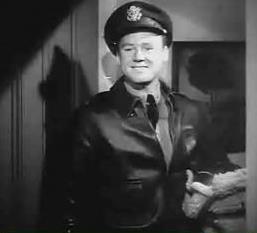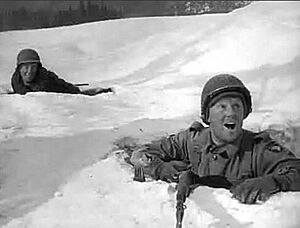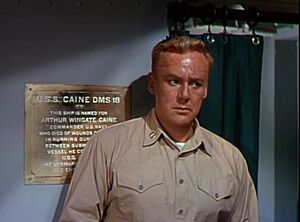Van Johnson facts for kids
Quick facts for kids
Van Johnson
|
|
|---|---|
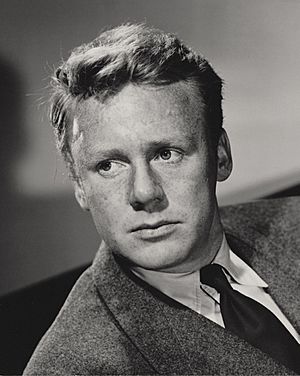
Johnson in 1947
|
|
| Born |
Charles Van Dell Johnson
August 25, 1916 Newport, Rhode Island, U.S.
|
| Died | December 12, 2008 (aged 92) Nyack, New York, U.S.
|
| Occupation | Actor |
| Years active | 1935–1992 |
| Spouse(s) |
Eve Lynn Abbott Wynn
(m. 1947; div. 1968) |
| Children | 1 daughter, 2 stepsons, including Tracy Keenan Wynn |
Charles Van Dell Johnson (born August 25, 1916 – died December 12, 2008) was a famous American actor. He starred in movies, TV shows, plays, and radio. He became a very big star at Metro-Goldwyn-Mayer (MGM) during and after World War II.
People often described Johnson as the "boy-next-door." This friendly image made him a popular Hollywood star in the 1940s and 1950s. He often played a red-haired, freckle-faced soldier, sailor, or pilot in MGM films during the war. Some of his well-known war movies include Thirty Seconds Over Tokyo, A Guy Named Joe, and The Human Comedy. He was one of the last surviving big stars from Hollywood's "golden age" when he passed away in 2008.
Contents
Early Life and First Steps in Acting
Van Johnson was born in Newport, Rhode Island. He was the only child of Loretta and Charles E. Johnson. His father was a plumber who came from Sweden. His mother had Pennsylvania Dutch family. His mother left the family when he was young.
After finishing high school in 1935, Johnson moved to New York City. He started performing in small shows.
From Broadway to Hollywood
Johnson first worked as a substitute dancer in a theater group. His acting career truly began in a Broadway show called New Faces of 1936. Later, he worked in summer plays near New York City. In 1939, a famous director named George Abbott gave him a role in Too Many Girls. He also filled in for the main male actors.
Johnson even had a small, uncredited part in the movie version of Too Many Girls. This film starred Lucille Ball.
A New Start at MGM
Johnson was about to move back to New York. But Lucille Ball introduced him to a casting director from MGM. This meeting led to screen tests for Hollywood studios. His test at Columbia Pictures didn't go well. However, Warner Brothers signed him for $300 a week.
He played a young reporter in the 1942 film Murder in the Big House. For this role, his hair and eyebrows were dyed black. But Johnson's friendly, all-American look didn't fit the tough movies Warner Brothers made. So, they let his contract end.
Soon after, Metro-Goldwyn-Mayer (MGM) signed him. MGM helped him improve his acting, speech, and how he spoke. He then had a small part as a soldier in Somewhere I'll Find You (1942). He gained more attention in The War Against Mrs. Hadley (1942). This encouraged MGM to cast him in their popular "Dr. Kildare" film series. Johnson played Dr. Randall Adams in Dr. Gillespie's New Assistant (1942).
MGM then cast Johnson as Mickey Rooney's soldier brother in The Human Comedy (1943). This movie was a huge success. He continued playing Dr. Randall Adams in Dr. Gillespie's Criminal Case (1943). He also wore a military uniform again for Pilot No. 5 (1943).
Becoming a Major Star
Johnson's big break came with the movie A Guy Named Joe. He played a young pilot whose guardian angel is a pilot who passed away. During filming in 1943, Johnson was in a serious car accident. He had a metal plate put in his forehead and scars on his face. MGM wanted to replace him in the movie. But the star, Spencer Tracy, insisted that Johnson finish the film.
A Guy Named Joe was a massive hit. It made over a million dollars in profit. This movie made Van Johnson a true star.
His injuries from the car accident meant he didn't have to serve in World War II. Many other actors were fighting in the war. This actually helped Johnson's career a lot. He was very busy, often playing soldiers. He once joked about this time, "I remember… finishing one Thursday morning with June Allyson and starting a new one Thursday afternoon with Esther Williams. I didn't know which branch of the service I was in!"
MGM made Johnson famous as the all-American boy. He starred in war movies and musicals. His first main role in a big movie was the musical Two Girls and a Sailor (1944). This was a huge success and his first film with June Allyson. He also played Ted W. Lawson in Thirty Seconds Over Tokyo (1944). This film told the true story of the Doolittle Raid on Tokyo in 1942.
Post-War Success
After the war, Johnson's career continued to soar. He starred in Thrill of a Romance (1945) with Esther Williams. He also appeared in Week-End at the Waldorf (1945) with Lana Turner and Ginger Rogers. In 1945, he was as popular as Bing Crosby at the box office.
He worked with Esther Williams again in Easy to Wed (1946). He also supported Spencer Tracy and Katharine Hepburn in State of the Union (1948). In 1949, he starred with Judy Garland in In the Good Old Summertime. This movie also featured Liza Minnelli as their young daughter. He then appeared in Battleground (1949), a movie about the Battle of the Bulge.
Johnson played an officer leading Japanese-American troops in Europe in the film Go for Broke! (1951). He was also reunited with June Allyson for Too Young to Kiss (1951).
Critically Praised Roles
MGM lent Johnson to Columbia Pictures for The Caine Mutiny (1954). He played Stephen Maryk. He chose not to hide his facial scars for this role. He believed they made the character more real. Critics later said that Johnson "was a better actor than Hollywood usually allowed him to be."
Johnson then teamed up with Gene Kelly in Brigadoon (1954). His last film for MGM was The Last Time I Saw Paris (1954).
Johnson actually liked working under the old "studio system." In 1985, he said his years at MGM felt like "one big happy family." He added, "Everything was provided for us... All we had to do was inhale, exhale and be charming."
Later Career and Life
In the 1950s, Johnson continued to act in films. He also made many guest appearances on television. He received good reviews for the dramatic film Miracle in the Rain (1956). He played a kind young soldier preparing for war. He also starred in the mystery 23 Paces to Baker Street, where he played a blind writer in London.
Johnson appeared as the main character in The Pied Piper of Hamelin. This was a musical TV special based on Robert Browning's poem. It was very popular and was shown every year for many years.
In 1959, Johnson turned down the chance to star as Eliot Ness in The Untouchables. That role went to Robert Stack, and the show became a big TV hit.
Johnson also guest-starred on Batman in 1966. In the 1970s, he appeared on shows like Here's Lucy and Murder, She Wrote. He played a main character in the 1976 TV miniseries Rich Man, Poor Man. He was even nominated for an Emmy Award for that role.
In the 1970s, after battling cancer twice, Johnson started performing in plays again. In 1985, he returned to Broadway in the musical La Cage aux Folles. That same year, he had a supporting role in Woody Allen's movie The Purple Rose of Cairo. At 75, he toured in Show Boat as Captain Andy. His last film was Three Days to a Kill (1992).
Personal Life
Johnson married Eve Abbott in 1947. Their daughter, Schuyler, was born in 1948. He also became a stepfather to Eve's two sons. The couple separated in 1961 and divorced in 1968.
Later Years and Passing
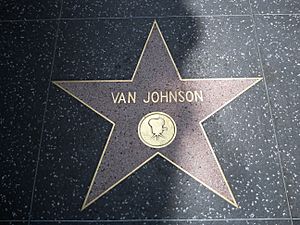
Van Johnson stopped acting in the early 1990s. He lived in a nice apartment in New York City. In 2002, he moved to an assisted living facility. He passed away there on December 12, 2008, at the age of 92.
Legacy
Van Johnson was never nominated for an Academy Award. During his most famous years, he was known for his happy and friendly presence on screen. After he passed away, one critic said that Johnson was "capable of an Oscar-worthy performance." For his important work in movies, Van Johnson has a star on the Hollywood Walk of Fame. You can find it at 6600 Hollywood Blvd.
Images for kids
-
Van Johnson's hand prints in front of The Great Movie Ride at Walt Disney World's Disney's Hollywood Studios theme park
See also
 In Spanish: Van Johnson para niños
In Spanish: Van Johnson para niños


